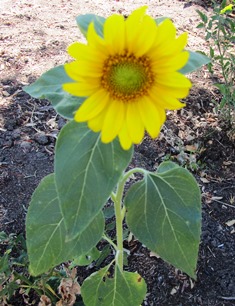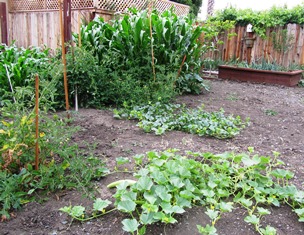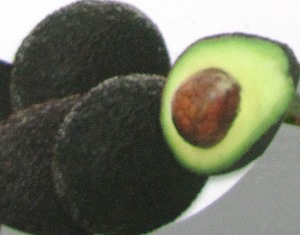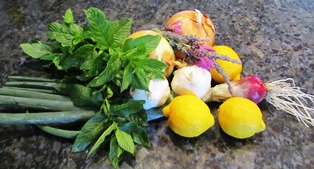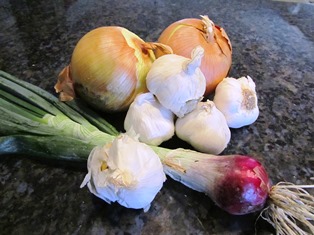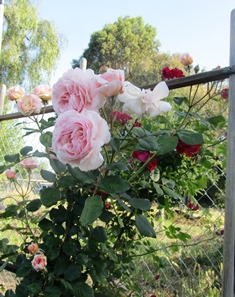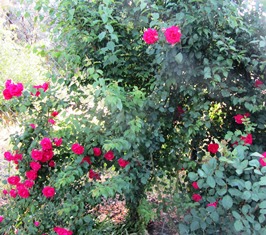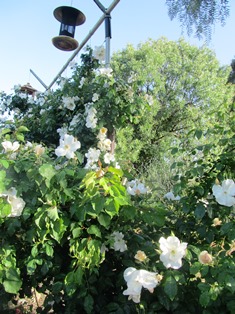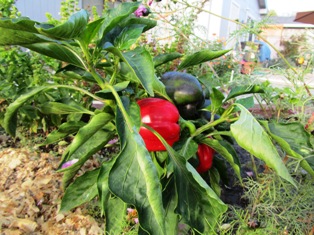Archive for the 'Plants and Trees' Category
The Versatility of Sunflowers
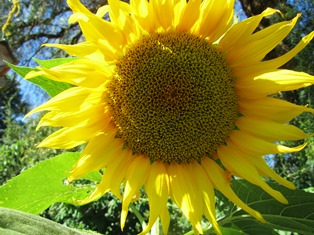
Grow giant sunflowers at the back of the garden or along a fence to support thick stalks and large dinner-plate sized heads
We planted a few sunflowers this year. One rises up maybe ten feet tall and its thick stalk supports a head the size of a toilet seat, no kidding. Sunflowers are beloved by many gardeners because they have myriad uses.
A few notable things about sunflowers: their lovely yellow petals can be used to make dye. Their stalk pith can be used to make paper. The seeds feed humans as well as animals and birds. And oil from the seed is used in cooking and also to create assorted cosmetic products and soaps.
Growing sunflowers is easy and the plant itself is fairly trouble-free. They like their summers hot and long and thrive in plenty of sunshine. You can plant them along a fence to help support the giant heads and thick stalks or tuck the smaller sized sunflowers into beds. They aren’t fussy about soil and do best when watered deeply but not often.
They attract butterflies, bees, birds, and squirrels. Dry the heads by hanging them upside down. I like to buy organic, non-genetically modified seed and save it from the heads each year in paper envelopes to plant the next summer.
Stressed-out Tomatoes and Corn
This has been a tough season for my tomatoes because of the heat wave California (and the southwest) recently endured and the gophers that showed up early.
The heat topped out at 105 degrees Fahrenheit on my patio this week. The patio isn’t far from my garden where I have heirloom tomatoes and corn growing. There are cherry and grape tomatoes, slicing tomatoes, a tomatoes for paste. I’m also growing there and elsewhere on the property patches of corn, eggplant, pumpkins, summer squash, and other veggies.
Just when the second planting of corn in my garden had reached the fragile pollination stage, the heat wave hit. Such extreme summer heat stresses corn. In just one week, despite all the watering, an entire section of the corn dried, the moisture of the ears diminished, and some of the dried tassels blew away in the hot wind.
I’m worried that with the global warming problem, we Northern Californians who have always enjoyed the Mediterranean climate here will be experiencing more of this intense heat in coming years.
Growing Avocados
My daughter, whose kitchen looks out over a side yard, asked me for an avocado tree. Her birthday was approaching so I suggested the tree be my present to her. We had a thriving avocado years ago along the side yard of our family home. I suppose she missed that tree.
I had no idea that avocados do not necessarily thrive in Northern California. Some cultivars are hardier than others. They are a subtropical fruit tree and mature trees require roughly 150 gallons of water a week to survive (except in winter). They also need a lot of heat, good drainage, and little to no competition from other trees.
The avocado along the fence of our family home (the tree belonged to our neighbor) eventually became infested with termites. The tree was cut down to about two feet tall, treated, and it bounced back.
The tree I planted for my daughter made it through the East Bay winter here last year and it snowed, albeit just a dusting. So I was pleasantly surprised to see how well the tree is doing now. My daughter hopes for fruit this year or next. We’ll see.
Avocado trees need to be fed throughout the year. They need nitrogen (but also phosphorus and potassium) in a balanced fertilizer like Scotts Turf Supreme. The trees are shallow rooted and like sandy loam soil. Clay soil like what we have here on the farmette must be amended with gypsum and compost.
Some avocados will need a pollinator; others like Stewart, the type of avocado I planted for my daughter, is self-fertile. If you keep bees or live near a beekeeper, the bees will do the pollinating for you. Otherwise you might need to hand pollinate using a small brush. For more information, see http://www.gardenguides.com/108300-pollinate-avocado-trees.html
Harvesting and Saving Sunflower Seed for Replanting
Last year, my sunflowers were gigantic and gorgeous. I removed heads as large as dinner plates for drying so I could plant the seeds again this year. Some of the smaller heads contained seeds that were totally black. I figured the bees had done some magic with cross pollination of other sunflowers from the neighborhood.
I stored the heads in my garden shed over the winter, but never got around to removing the seed for replanting. When I went into the shed to retrieve them for planting last month, I discovered with dismay that something had devoured most of the seeds. A few seeds were left so I optimistically tucked them into the ground. Alas, none germinated.
Determined not to let that ever happen again, I recently bought four packets of open-pollinated, heirloom sunflower seed. After they grow, I’ll harvest and preserve the seed correctly at the end of summer so I’ll have plenty to plant next year. When you use open-pollinated, heirloom seed, next year’s plants will come true to the characteristics of the parent. This is not the case, however, with hybrid seed.
In case you might be interested in harvesting and storing sunflower seeds, too, here are the steps.
1. When the sunflower heads have turned from green to brown, remove the head from the stalk with a knife.
2. Let the head dry for a few weeks to a month in a dry place, safe from marauding squirrels and racoons. You can tie the heads with string and hang them from the ceiling in a drying shed or place them on paper.
3. Shake or gently bang or otherwise extract the seed onto paper from the dried heads.
4. Store the seed in paper envelopes and label them with the date and type of seed.
Letting a Plant Go to Seed
Some lettuces, basil, and Greek oregano have spontaneously appeared in my garden. No surprise in that since I let some of my herbs and vegetables go to seed last year.
We used the rototiller on the garden area twice before planting this year. By the time we turned the soil, the vegetables and herbs I had planted last year were a memory. That said, some certainly did re-seed and the evidence of that are the new plants popping up where I didn’t plant them this year.
Open-pollinated vegetable and herb seeds, well tended (meaning, meeting the seed needs of light, water, and good soil), will go through the cycle of sprouting, pushing up through the earth, blooming, bearing, and dying. If you let your plant go to seed and the wind broadcasts the seed or it drops, you will likely (in the case of oregano, basil, chives, and other herbs and some vegetables) get new offspring.
The plant that the mother seed produced will also yield seed (and if you are smart and save some), that seed will repeat the same cycle and the vegetable will also be a true likeness of the original seed. Everything starts with the integrity of the seed.
This is why open-pollinated (OP) seed continue to perform in the same way their ancestors have for hundreds, even thousands of years. And nature’s plant cycles make that possible.
Fairy-Folks Fingers Look Great in Borders and Beds
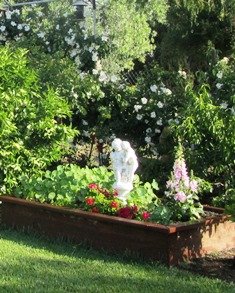
Foxglove flowers look like bells or the fingers of a glove making an attractive spire on a leafy stalk
In the folklore of Wales, the Foxglove plant is commonly known as “fairy-folks fingers” and also “lambs tongue leaves.” Americans recognize it the digitalis plant, an old-favorite for flower gardens.
Foxglove’s botanical name is Digitalis purpurea but gardeners in Great Britain (especially Scotland and Wales) where Foxglove grows as a wildflower know it by more colorful names: Bloody Fingers, Witches Bells, Dead Man’s Fingers, Fairy Caps, Fairy Glove, Virgin’s Glove, Folk’s Glove, and Fairy Thimbles.
My garden and planter boxes include several Foxglove plants ranging in color from white to a dusty shade of rose. The flowers are tubular and measure between 1 1/2 to 2 1/2 inches. Because the plants can grow 2 to 5 feet tall, they are especially good choices for color at the back of a flower bed.
Foxglove plants are considered poisonous. But the plants readily re-seed themselves, are excellent cut flowers for a summer bouquet, and are deer resistant. Plant in full sun or light shade and keep the soil moist, albeit well-drained.
Best time to plant Foxgloves is in the spring or fall. When cutting blooms from the plant, remember that cutting the central upright stalk will cause the plant to produce lateral shoots for new blooms. If the plant is not cut, the flowerheads produce seed that self-sows. If you want an elegant back border for your flower garden, consider planting Foxgloves. Plants are available in many colors are low maintence.
Natural Medicines For Healing and Health
Recently, I went through a box of books that I had not unpacked after moving from Miami to Northern California. In the box was Best Remedies, a book written by Dr. Mary L. Hardy, M.D. and Debra L. Gordon for Reader’s Digest.
The book focuses on ways to use natural remedies alone or with conventional medicines in an integrative approach to healing. Many of the remedies involve the use of herbs, honey, vegetables, and oils. Listed below are just a few remedies to treat common maladies.
Chamomile
Chamomile is an herb that when made into tea can be used as a mild sedative and also fights the inflammation of a sore throat. Likewise lemon and honey in hot water can soothe swollen throat tissue.
Echinacea
For treating colds, a tincture of Echinacea purpurea and Echinacea angustifolia can provide relief when made into a tincture and mixed with hot water. Authors Hardy and Gordon recommend 1/4 – 1/2 teaspoon of the tincture in 1-2 ounces of hot water to be consumed every four to six hours.
Garlic
Traditionally used as an herbal remedy for respiratory infections, garlic, to be most effective, must be consumed raw. The best way is to peel and mash 3-4 cloves into pasta, rice, or mashed potatoes.
Ginger Root
For treating bad breath, tea made from ginger root (1- to 2-inch pieces, peeled and steeped in hot water, sweetened with honey) or peppermint tea (all types of mint are easily grown in the garden or in containers) can be effective agents.
Lavender Oil and Aloe Vera
Oil of lavender works as an inflammation and pain reducer while acting as an antiseptic; therefore, it’s a wonderful natural agent for treating minor burns. Once you have applied the lavender oil, you can also apply the sap of an aloe vera plant. Aloe reduces the pain of a burn and promotes healing.
Lemon Juice and Honey
Honey, one of nature’s antiseptics long used to treat respiratory ailments, provides a protective coating of the throat and acts as a humectant (drawing moisture) while the lemon works as an astringent to reduce swelling of inflamed throat tissue.
Olive Oil, Beeswax, and Honey
These three ingredients mixed together in equal parts can be used to treat psoriasis, a disease characterized by itchy, scaly skin. The authors recommend smoothing the mixture onto the affected area of skin before going to bed at night and then covering the skin with plastic wrap, held in place with an elastic bandage.
Onions and Garlic
Onions and garlic are recommended as two vegetables that can lower blood sugar, cholesterol, and blood pressure. Onions are high in vitamin C and, and like garlic, contain immune-enhancing compounds. Garlic reduces blood clotting (thus, preventing heart attacks) and raw garlic has strong immune-stimulating properties as well as antibacterial and antiviral benefits. For people with chronic diseases such as Type 2 Diabetes, these foods should be a regular part of the diet, according to Hardy and Gordon.
St. John’s Wort
St. John’s wort essential oil–10 drops to 1 ounce massage oil–massaged into the skin over painful areas over time may result in relief from nerve pain. Patients who have fibromyalgia, diabetic neuropathy, shingles, Lyme disease, autoimmune disorders, and other types of diseases can suffer nerve pain as stabbing, burning, and shooting sensations. Other herbs believed to revitalize nerve and brain cells include Gotu kola (an herb considered a mainstay in Ayurvedic medicine) and Evening primrose oil that fights inflammation and is found in black currant and borage oil.
Grow these herbs in a garden or in containers on your patio for use to restore and maintain health and also for enhancing flavors in your cooking.
Seven Tips for Growing Sweet Corn
Nothing says “summer” like juicy ears of sweet corn. Corn (or maize, as it is called in much of the world) isn’t difficult to grow but following a few tips can ensure success in growing this amazing plant.
What would a summer backyard barbecue be without a platter piled high with corn on the cob? And what could be better than picking it fresh?
We planted corn last year and still had a few ears that the squirrels hadn’t found. When I discovered them a few weeks ago, I removed the dried husk and planted some of the seed. Amazingly, the seeds grew and are now over a foot tall.
If you want to grow corn, it is helpful to understand several points.
1. Corn seeds won’t germinate in soil colder than 50 degrees. So wait until the soil is warm to plant your seeds.
2. Wind is the pollinator for corn, so do not plant your seed corn in straight rows. Instead, plant the seeds in blocks. Corn is monoecious, meaning the male and female parts are on the same plant. Block planting enables better pollination.
3. Plant corn kernels (two or three seeds) 15 inches apart in rows 30 to 36 inches apart.
4. After planting the corn seeds, water well. Corn needs plenty of water and nutrient-rich soil high in nitrogen. Dig in some aged manure to help meet the corn’s nitrogen needs.
5. Fertilize plants when they have reach 12 to 15 inches in height.
6. Weed often, but take care not to damage the corn roots. Compost can help keep weeds at a minimum and also adds nitrogen to the soil.
7. To harvest corn, bend the ear downward and twist from the plant. Remove husk and silks before cooking or freezing.
A little known fact about sweet corn comes by way of horticultural specialist Jonathan R. Schultheis, University of North Carolina Extension, who notes that the first known variety of sweet corn, Papoon, was acquired from the Iroquois Indians in 1779. See, http://www.ces.ncsu.edu/hil/hil-13.html
Whether you call it sweet corn or maize or classify it as vegetable or grain–these terms won’t matter as much as the word, “delicious” when it comes time to serving your home-grown corn to family and friends.
Climbing Roses Put On a Show for Spring
I confess I’m a rose lover. This time of year, the climbing roses we’ve planted are clambering up on wooden trellises, chain link fences, and even the wall of the chicken house, putting on a spectacular display. What’s not to love?
Here in Northern California’s inland valleys, these climbers offer their most magnificent displays of color, shape, texture, and scent during spring. Most do well with a season-long balanced fertilizer, water, and pruning to remove dead canes and spent flower heads. Mulch with organic matter to conserve water and keep down the weeds.
Climbing Handel features cream-colored blooms, edged in a rose shade of pink. It is hardy, has glossy green foliage, and upright pillar growth.
Climbing Don Juan grows upright and has a tendency to spread out. Its canes produce red flowers that are 3 to 6 inches in diameter. The plant blooms from spring until frost.
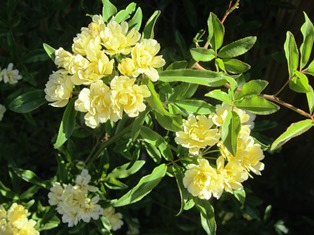
Lady Banks is a species rose named after the wife of Sir Joseph Banks, legendary head of the Royal Horticultural Society of Great Britain
Climbing Lady Banks scampers up our chicken house wall and explodes into a profusion of hundreds of disease-resistant yellow roses on long canes without thorns. This rose is not a hybrid, but rather comes from China and has been cultivated since 1796. To say it spreads is an understatement–the largest Lady Banks grows in Tombstone, Arizona where it covers 8,000 square feet.
Climbing Sally Holmes is a showoff in our garden. The pointed-shaped buds start out cream-colored (tinged in pink) and then open into an white bloom with a light, sweet fragrance. The rose can climb 12 feet, the height ours has reached where it grows along the back fence.
The vigor of Sally Holmes means it can easily be grown from cuttings. In fact our massive climber was grown from an arm-length cutting dusted with root hormone that we stuck in the ground three years ago. We’ve taken many cuttings since to start the climber elsewhere on our property.
If you have the space for climbers, consider giving one or more a try. Although they are hardy, often disease-resistant, and reward with spectacular displays of bloom, they need support, so think pillars, arbors, gazebos, porch railings, and fences.
Learning about GMO Food Safety
You might assume your zucchini and sweet corn is safe to eat but what if it was grown from GMO-treated seed, able to withstand an herbicide or even produce an insecticide as it grows? What happens in your gut when you eat that corn? What happens to animals fed such corn? These are questions that scientists, doctors, consumers, food safety advocates, and environmentalists all grapple with in their concern about GMO food safety.
The Non-GMO Project is a nonprofit organization concerned with GMOs and food safety. It explains on its Web site that a genetically modified organism (GMO) is a plant or animal that has been “genetically engineered with DNA from bacteria, viruses, or other plants and animals.” That means it is an anomaly in nature as such experimental combining of genes of different species does not occur in traditional crossbreeding or in nature (http://www.nongmoproject.org/learn-more).
Consumers might not be getting all the facts of what is known and what science is discovering about the health concerns of many Americans eating foods that contain GMOs. Estimates suggest that 80 percent of U.S. processed foods contain GMOs, meaning millions of Americans are eating foods that might not be all that safe to consume. Research into links between GMO consumption and ill health are ongoing but already GMO-altered foods, whether plants or animals, are raising health concerns.
Seed suppliers say that interest in non-GMO corn seed is growing among farmers because of lower costs, better animal health, and higher yields as well as increasing disenchantment with genetically modified traits of GMO seed (http://www.non-gmoreport.com/articles/january2013/Demand-growing-for-non-GMO-corn-seed.php)
With summer on the horizon, many people are planting seeds or seedlings in their gardens or are anticipating the plentiful vegetables available at produce stands and in supermarkets. But read the labels on all those mounds of squash, tomatoes, peppers, and potatoes.
Potatoes and tomatoes are considered low-risk for GMOs by the Non-GMO Project, that is, those two vegetables are not currently being genetically engineered. Although many people might think wheat is a concern, the Non-GMO Project states that wheat is not now nor ever has been genetically engineered, unlike soy, cotton, sugar beets, alfalfa, canola, zucchini, and summer squash.
More than 60 countries, including most of the developed nations, have banned or restricted GMOs. The United States is the exception, allowing production and sale of such products to continue. Consumers, scientists, and environmentalists opposed to genetic manipulation of plants and animals say avoidance and boycott of such products are consumer choices even as legal battles against bio-tech giants and anti-GMO advocates move through the courts.
As for summer corn, the best option might be to grow your own from heirloom seed that has not been genetically maniuplated. Otherwise, buy corn certified as non-GMO or from sources that support organic farmers and food sources such as Whole Foods and other organic markets. Check out the offerings for seed at Seeds Now (http://www.seedsnow.com/pages/shop-all-seeds).
 Facebook
Facebook Goodreads
Goodreads LinkedIn
LinkedIn Meera Lester
Meera Lester Twitter
Twitter




